Continued from page 1
BIM
Building Information Modeling is still the rage it’s been for a half decade; most of the AEC industry at the larger firm size end of the spectrum have moved to BIM or are in the process now. BIM comes in various levels, 1 through 3, from the lonely architect just making his or her simple 3D model of a project to the large enterprise-sized practice with the Fortune 500 client that can include everything: piping, ducts, wiring, and structural framing, as well as the overall architectural design. The vast majority of architects don’t work on larger buildings as 80 percent of all firms, say, in the United States, are smaller practices. So the dream of doing level 3 BIM for many will remain mostly a dream.

06 – A huge new feature for BIM users is the Revit import functionality. Now consultant BIM models, like MEP, can drop into Vectorworks via Revit Import.
Big BIM, as some in the industry define it as opposed to ‘little BIM,’ would include the work of all the consultants. And this is where the interesting question comes up. Is Vectorworks truly capable of big BIM? That depends somewhat on how you look at it. Vectorworks itself is capable of producing an architectural model suitable for the most demanding levels of BIM. But can it integrate the work of all the consultants?
For years, the largest AEC software company, Autodesk, took an approach that sought to create a BIM product (Revit) for all the consultant fields adjacent to the architect. This path makes it easy for file and data compatibility. Other industry software giants (and smaller rivals) adopted an approach embraced by the Nemetschek Group and its companies, of which Vectorworks is a part. Using IFC (Industry Foundation Classes) as an interoperability layer (and file type) the wider industry can interoperate with various ‘best-of-breed’ software tools for a truly wide set of industry issues.
Despite IFC as an industry standard, the Revit BIM world is large enough such that many standard building element objects are created and saved in native Revit file format. To address this, along with making it easier to support consultants who use Revit MEP or Structural, and are less skilled at IFC workflows, Vectorworks Architect 2017 now supports native Revit import. Next year, implementing export functionality is planned.
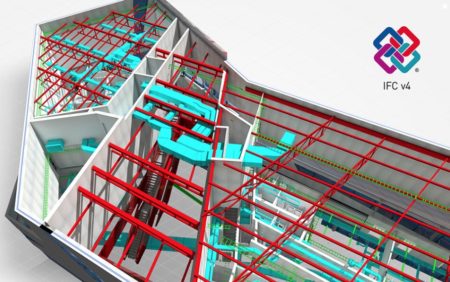
09 – Vectorworks 2017 supports the latest IFC 4 standard by buildingSMART for industry-wide BIM collaboration of data. The application also supports BCF (BIM Collaboration Format) another buildingSMART standard.
Supplementary to Revit import is new IFC-4 standard support, along with another buildingSMART-based (they shepherd IFC) standard for the industry, BIM Collaboration Format (BCF). BCF manager equips architects with the resources to share, edit, and assign issues or clashes that need addressing to consultants. The format packages up a 3D view complete with annotation data and 3D model position data. A consultant then can open up a BCF link and the annotation data, view and geometry data are loaded into their particular BIM application, in one simple go.
BIMobject
This is an important addition this year because Vectorworks has suffered until now from a bit of a lack of attention from manufacturers. That is, when they create BIM model data of their building products, Vectorworks has sometimes been left out. Now with the BIMobject App this will not be a problem.
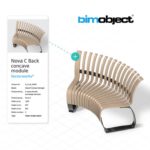
10 – BIMobject integration is new to Vectorworks 2017. Now architects have thousands of product BIM models at their disposal.
A quote from Vectorworks: “The App manages and downloads native Vectorworks content and easily converts DWG, SKP, and 3DS content into information-rich Vectorworks content. This is done entirely in the background and delivers the same user experience no matter the source data format. Additionally, the App includes over 4,600 objects from more than 260 brands, an unprecedented amount of content for a newly-introduced App.”
New Resource Manager
Here is a tool that is saving me a lot of time. The new Resource Manager is a complete makeover of the old one. Resources are all those things we use while designing and drafting; some, for example, are line types, hatches, wall types, plugin objects, symbols, and textures.
Graphically, the Resource Manager takes up a lot of monitor space because it consists of three columns. That is not a problem as it can easily be minimized when not needed. The first column is a list of files, favorites and libraries, second a graphic list of all the items in the currently selected library or search results and third a graphic of the currently selected item and some data about it.

11 – The tour-de-force new feature in Vectorworks 2017 is the new Resource Manager, a powerful new organizing tool for all your drawing and BIM object resources both internal and in the cloud.
Did I say “search”? Yes, this is the coolest part of the whole thing. Type in what you need and up pops a list of available items. It takes a bit of study to understand how all the features work and the search feature, though great, still needs some improvement. Select symbols and plugins and then search for tables for example. If you type ‘table’ you get one group; type tables you get another, or sometimes you get nothing but change the word slightly and get some results. Anyway, if you are working away and need some bathtubs for your model and don’t want to lose time going through a bunch of lists just search for bathtubs and whoops you get nothing, but search for bathtub and you get a bunch of them along with fixtures. It’s time saved.
Camera Match
Camera Match is a new Vectorworks, Inc., acquisition and the company has integrated this exciting product (which I once reviewed) into version 2017.
Camera Match does what its name implies. It matches the 3D perspective inherent in an imported image (think a photograph of a building site’s context) to the 3D geometry of the model in Vectorworks. Photogrammetry—the scientific term for this process—isn’t necessarily easy, and Architosh has reviewed such programs in its past. While Camera Match is one of the more accessible applications that handles this; my one complaint about it is that it could be made easier. There needs to be a real step-by-step in the help files.

12 – Camera Match is technology that was acquired recently. Now photogrammetry is a core feature in Vectorworks 2017.
This brings me towards closing thoughts and issues.
Help, Ease-of-Use and Service Select
I must say something about the help files because they are one of the things that make Vectorworks user-friendly. I have been referring to them a lot lately and in doing so found them to be quite useful. Searching the help files is fast, intuitive, and leads to step-by-step information.
For those switching from other CAD programs, particularly Windows-first CAD tools, Vectorworks at first blush can confuse you. The issue is: you are over-thinking it. Vectorworks works differently from almost all such tools; it’s closer to Adobe and Mac legacy UI/UX (user-interface/user-experience) apps. Its sister app, in spirit, in the world of 3D, would be Strata 3D.
If you are Windows-centric user switching to Vectorworks, a good start might be picking up a book by an expert like Jonathan Pickup or watching some YouTube videos. Not matter where you come from or how you start, on-ramping to this program isn’t that difficult.
Closing Comments
Vectorworks’ licensing involves both perpetual and subscription options. The latter is available through the Service Select program (see pricing below). Those in the latter program get exclusive benefits, like early access to releases, VIP access to new libraries, textures, et cetera, plus exclusive training, and increased storage capacity in Vectorworks Cloud Services—which happen to be open to everyone this year.
There are other features in this update that are worth mentioning by name. The new Slab Drainage tool is a power-user feature that will reportedly please many. It makes easy work of modeling drainage on flat roofs. The new irrigation tools in Landmark are also deeply impressive, and a feature actually implemented at the design level by a user. Also, it is now possible to import native Cinema 4D textures directly into Vectorworks, widening up the material possibilities for rendering. And finally, an exciting new feature for the Mac Vectorworks user is palette docking, as the Windows folks, already have.
While most of these new features and improvements will be sincerely welcomed and appreciated by most Vectorworks users, it doesn’t mean there are not areas for improvement. One area is in the area of rendering.
While Cinema 4D’s engine is superb, there is no denying that Chaos Group’s V-Ray renderer is by far the top high-end renderer in the market. Some of Vectorworks’ chief competitors have now implemented plugin support for not just V-Ray but other third-party renderers as well. Related to this topic, rendering in AEC is fast moving to ‘real-time’ interactive rendering programs, like LumenRT, Twinmotion, and others. The engagement and storytelling potential with interactive, real-time rendering are high. Having just high-quality photorealistic and artistic rendering built into a BIM program used to be enough five years ago. But times are changing quickly, and this is no longer enough.
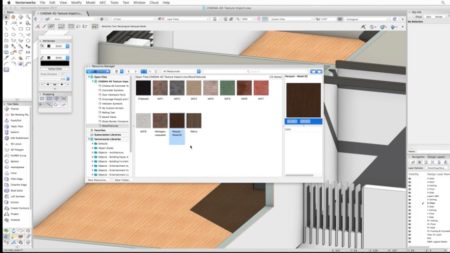
14 – This image shows a bunch of imported Cinema 4D textures. Once imported their more advanced channel levels can still over-written to produce differences in texture looks.
And related to this topic of rendering is that of animation—features in Vectorworks that the company has chosen not to put much time into over the past several releases. In our last review, we suggested saved views should be used as ‘key frames’ in new animation options, and perhaps accessible in a simplified tabbed interface type way. Finally, and this is the last point of contention, viewports can be used to make elevations and sections, but the process of making elevations is a bit confusing. There is no make elevation tool. Section viewports are great, and one trick is to use them to make elevations, but users shouldn’t need tricks for this.
Recommendations
Regarding recommendations? I have written this review on Word 2010. I don’t feel I need any new features with my word processor. And some Vectorworks users may feel content in that feeling about their CAD program of choice. But for those users who are questing for VR, collaboration features (such as file sharing), advanced rendering, and more “big or little BIM” features, Vectorworks 2017 offers a boatload of new capabilities and improvements. One great one not mentioned yet is the graphics performance improvements for 2D view. This one alone, along with other performance improvements, can be a game changer for those users who work with huge files.
But getting back to BIM, in particular, the mix of feature improvements in this release offers much to the user and coupled with everything else, Vectorworks 2017 is another excellent version worthy of upgrades and initial considerations. —- JOHN HELM, NCARB
Pros: The new Resource Manager is a superbly re-architected set of features that will build-out over many releases; the new web view and VR features keep Vectorworks on the leading edge of BIM tools in regards to virtual reality—with the devices just debuting this year; the new Vectorworks Graphics Module (VGM) improvements applied to 2D graphics will greatly speed up this area of your work; the Slab Drainage tool tops the list of pro-oriented BIM features, along with many others like structural members, Revit import, BCF support, IFC 4 support, and door and window styles features; Renderworks now included for everyone, new Camera Match, new 2D drop shadows, and separation of pen and fill opacity settings continue to put the shine on output to impress clients; Mac users finally get palette docking, and it’s pretty cool.
Cons: Vectorworks 2017 doesn’t currently support third-party rendering engines like the immensely popular V-Ray, nor does it include “interactive rendering” like many of its rivals are just starting to do through third-party or internal product family connections; working with “saved views” is still not as elegant as it should be and its long neglected animation features should respond to this; creating elevations from BIM models should be clearer.
Advice: For architects working in full BIM mode this update yields some attention-getting features like the new slab drainage and door and window styles features. However, the Revit import, BCF, and IFC 4 new additions are where the heavy lifting happens for many of the larger firms. As we predicted, version 2016 would be a tough version to match, but version 2017 comes close. Adding Renderworks for all users in all industry versions is an extremely attractive add. We have awarded Vectorworks Architect 2017 4.5/5.
Cost: Vectorworks Fundamentals 2017, $2,145.USD (new license)/ $751.USD (upgrade); Vectorworks Architect 2017, $2,945.USD (new license) / $1,031.USD (upgrade).

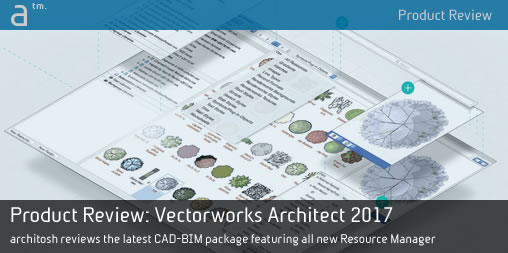


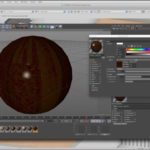


Reader Comments
Comments for this story are closed